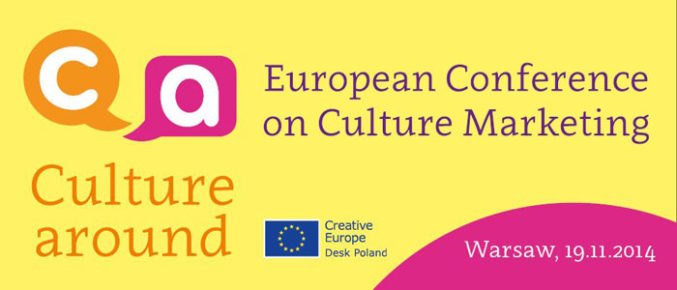
túra
On November 19th, 2014 in Warsaw, a conference ‚Culture Around‘ organised by Creative Europe Desk Poland took place. The event, focused on cultural marketing in Europe and targeted mainly at non-governmental organisations and independent culture-makers, was full of thought-provoking presentations.
It started off with a talk by Prof. Dr. Ariane Berthoin Antal from the WZB Berlin Social Center in Germany. Prof. Antal spoke about artistic interventions in business. Artistic interventions, Antal explained, are about bringing business and art together. Using a number of case studies, Prof. Antal revealed the necessity of the presence of art in a corporate environment. First, she talked about a company whose CEO decided to put his employees in a suprising context of theatre. With the help of a theatre group, they engaged in theatre-based exercises together with the CEO. Another example of an intervention mentioned by Prof. Antal was a residence programme which involved an artist creating works of art in a company setting for a longer period of time. This helped the employees familiarise themselves with the world of contemporary art right in their workspace. During her presentation, Prof. Antal made the audience aware that one should move away from the old input/output model in which an activity such as an artistic intervention is expected to bring immediate results like an increase in productivity, as it is the soft skills and the long term effect that count.
Another highlight of the conference was a presentation on culture marketing and audience development by Agata Etmanowicz from Fundacja Impact. Audience development, as Agata explained, simply means focusing on the audience while organising cultural events. She pointed out that the lack of a plan regarding a more focused and careful preparation of an event plan targeted at a specific audience is a problem that can be tackled with a bit of knowledge about audience development. More effort on the organisers‘ part when it comes to finding out who comes to their events and getting to know their public is the recipe for a bigger and happier audience, Agata concluded.
Two final talks of the conference were centred around case studies involving successful culture marketing in Europe. Veronique Bossaert from the Brussels Philharmonic told a heartwarming story about a Belgian orchestra which was on the brink of a crisis just a few years ago, and managed to come out of it stronger and more successful than ever before. Veronique emphasised that the orchestra’s success involved a major transformation of their image and goals; changing the name and the logotype, as well as embracing unfamiliar ideas such as composing downloadable mobile ringtones. These changes helped the orchestra widen their audience and contributed to major successes such as Academy and Golden Globe awards for film soundtracks. Finally, Odete Patrício from Fundação de Serralves in Portugal spoke about an initiative she is currently involved with, the Serralves contemporary art museum and park in Porto. The musem’s mission is to raise the general public’s awareness concerning contemporary art and the environment. Serralves, built in the 1990s, has come a long way to be recognised as one of the main Portuguese cultural institutions.
Useful links
Intermediary organizations enagaged in artistic interventions:
https://www.facebook.com/TILLT.Europe
http://conexionesimprobables.es
https://www.facebook.com/UnternehmenKulturwirtschaft
Fundacja Impact: http://www.art-impact.pl
Brussels Philharmonic: http://www.brusselsphilharmonic.be
Fundação de Serralves: http://www.serralves.pt
